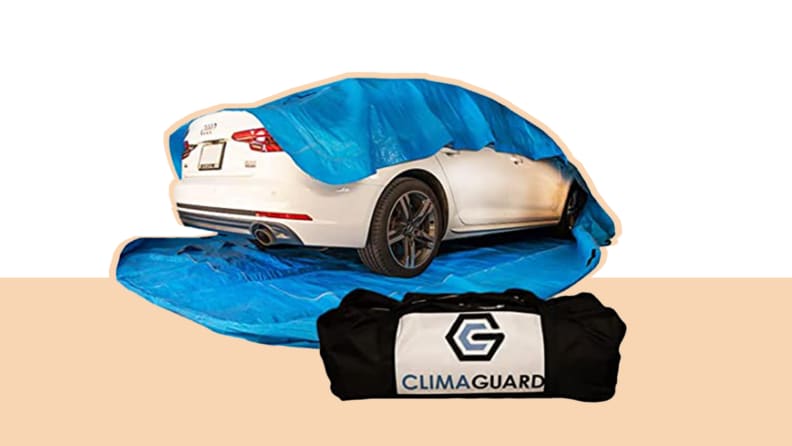4 ways to prevent flood damage to your car during a storm
Live in a flood zone? Here’s how to protect your car
Products are chosen independently by our editors. Purchases made through our links may earn us a commission.
California is currently experiencing intense flooding and mudslides following historical rainfall on Sunday. Many parts of Central and Southern California have been affected including Los Angeles and Orange County.
If you’re worried about more flooding and are looking to mitigate flood damage to your home and belongings, there are several ways to protect them, including wet and dry floodproofing, and creating flood barriers around your property.
Will these measures also protect your car from the hazards of a major storm, like rising water, wind, and salt damage? Sometimes, yes, but there are plenty of additional ways to make sure your automobile will successfully weather upcoming storms. After all the money and hard work it took to get your car, you’ll want to do everything possible to ensure it’s not washed away or flooded during the next storm.
Here’s what you need to know.
Where is the flooding in California?
Flooding has occurred throughout Central and Southern California including Los Angeles County, Orange County, Riverside County, Ventura County, and Bakersfield.
What is a flash flood?
Flash flooding describes a flood that occurs within six hours of heavy rainfall.
Why is there flooding in California?
California’s current flooding is due to a heavy rainstorm that began Sunday caused by an atmospheric river, a narrow band of moisture-heavy air that can travel across long distances.
Cars vs. water
Aside from homes, a car can be the largest asset many people own, and it’s well worth the effort to protect your investment.
A flood can irreparably damage a car, starting with electrical problems. Water in the engine can cause corrosion and short out the electrical system. If water mixes with things like oil, transmission fluid or lube, it can also cause further internal damage.
If the flooding is the result of a rise in salt water rather than fresh water, that damage and corrosion becomes exponentially worse.
From a safety perspective, it goes without saying that if your car is stuck in flood waters, you should never try to drive through it. If you find yourself driving toward rising or standing water, turn around, if possible, and seek higher ground. According to the Centers for Disease Control, the most common flood-related deaths occur when a vehicle is driven into hazardous floodwater.
For most passenger vehicles, it only takes about six inches of water to reach the bottom and affect the vulnerable components of the car, which can trigger extensive, expensive damage throughout.
So, how can you avoid a total loss and protect your vehicle in the event of flooding and prevent a flooded car?
1. Obtain the right kind of auto insurance coverage
Before you start to worry about hurricane season, having flood insurance that covers your car is important.
Greg Howes, the CEO of the Howes Insurance Group, explains, “Auto insurance covers flood damage, as long as you carry the comprehensive coverage part of the policy, subject to the deductible.”
Comprehensive coverage covers damage from most things that fall outside the scope of collisions, including theft or vandalism, and acts of nature, including storms and floods. This is essential to know in the event you need to submit an insurance claim.
If you own boats, campers, or other recreational vehicles, Howes adds, “As long as you elect physical damage coverage, there are no exclusions for floods and/or hurricanes,” though he notes that not every policy offers the same coverage, and suggests reviewing your policies with an insurance professional before the need to potentially file a claim, as policies and insurance companies differ.
It’s also important to note that if your car is parked inside a garage or elsewhere on your property and receives flood damage, it will not be covered by your home insurance policy.
2. Move your car to higher ground
Howes explains, “To mitigate flood damage to your vehicles, the only real option you have is to move your vehicle away from the flood area to higher elevations.”
This means that if your home is in a flood zone and your home is not surrounded by flood barriers of any kind, you’ll want to leave your car somewhere higher and safer. During a flood, there’s simply no way to remove water from your vehicle.
3. Floodproof your garage
Dry floodproofing your home is an effective way to prevent water from entering it, and it’s an equally effective measure for your garage.
Dry floodproofing involves sealing off the garage to keep flood waters out. This means that any areas below the structure’s flood protection level are made watertight using plastic or rubberized sheeting or special waterproofing compounds.
In addition, exterior walls and/or floors are sealed with compounds that are applied directly to the surface of the structure to help the building resist water penetration.
Dry floodproofing is a great option for non-residential structures like garages and sheds where vehicles may be stored, and it’s a relatively inexpensive option compared to wet floodproofing.
Dry floodproofing can’t truly guarantee that water won’t seep into your car, but there are a few more products you can use to help protect your vehicle from flood damage.
4. Create a barrier between your car and flood waters

The ClimaGuard car cover is your best defense against the elements with military-grade polyethylene materials.
A protective car cover is a relatively inexpensive short-term solution for protecting your car against the elements.
Made of weather-proof materials, this type of car cover is portable and can be used inside or outside of a garage. It can also be used to protect other types of vehicles or valuables from water damage.
While flood water may be a temporary concern, salty sea spray and the humid air in coastal communities can also contribute to internal corrosion and external rust and damage to car door panels or the hood.
This type of car cover can also slow down the corrosive damages caused by continued exposure to salty spray and air. The less damage, the less it will cost you to repair the vehicle.
Temporary flood barriers, such as water-filled, expandable dams, or sandbags that can be stacked and placed around the perimeter of your car, are also a worthwhile—but temporary—investment.
Water dams and sandbags can provide short-term protection, barricading your car from possible flooding, though they will only provide protection up to a maximum of two feet. When constructing a sandbag wall, using a waterproof tarp to add an extra barrier is also recommended.



